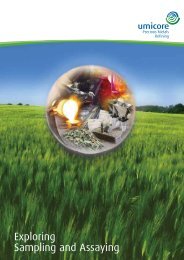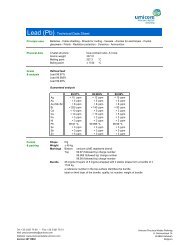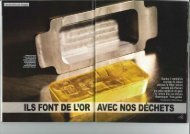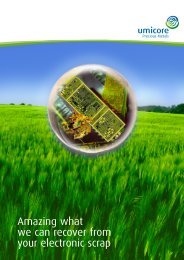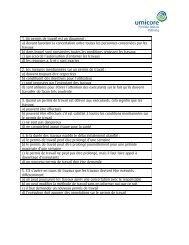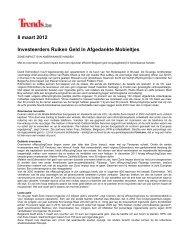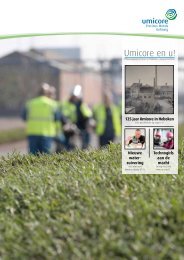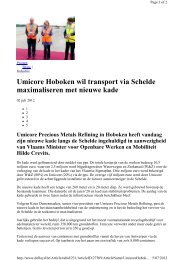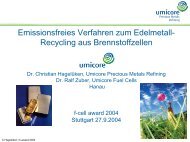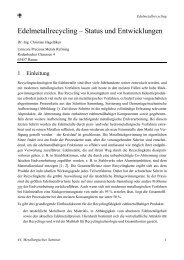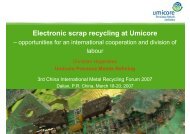full screen - Umicore Precious Metals Refining
full screen - Umicore Precious Metals Refining
full screen - Umicore Precious Metals Refining
You also want an ePaper? Increase the reach of your titles
YUMPU automatically turns print PDFs into web optimized ePapers that Google loves.
1. A work permit is a document:<br />
a) that is meant to promote consultation amongst all individuals that are involved<br />
in the work activities<br />
b) wherein the conditions to be followed during the work process are specified<br />
c) that grants permission to start with the work activities<br />
d) the answers a, b and c are correct<br />
2. The measures mentioned on a work permit:<br />
a) must be followed at all times<br />
b) serve as a guideline for the user of the permit<br />
c) are established by the worker carrying out the work activity<br />
d) are used to alert the workers carrying out the work activity to exercise the<br />
greatest possible caution<br />
3. When a work permit is issued to the workers that will be carrying out the work<br />
activity, this does mean that the work:<br />
a) may be carried out<br />
b) may be carried out when all conditions mentioned on the permit have been<br />
fulfilled<br />
c) does not present any risks or hazards<br />
d) presents no health hazard<br />
4. In case the work activities last longer than scheduled:<br />
a) the permit may then be extended by one week<br />
b) the permit may then be extended on a daily basis for a period of maximum<br />
one week<br />
c) the permit may not be extended but more workers should be employed on the<br />
job<br />
d) a new permit must then be applied for<br />
5. If it appears in the course of the work activity that the work ought to be carried<br />
out in a different way:<br />
a) one may proceed with the job following consultation with the principal<br />
b) one may do so without informing anybody of the change<br />
c) a new permit must be applied for<br />
d) the worker carrying out the work must to that effect make a note on the work<br />
permit
6. What does this pictogram signify?<br />
a) warning of a possible danger<br />
b) an evacuation passage way<br />
c) fire-extinguishing material<br />
d) direction to the washrooms<br />
7. What does this pictogram signify?<br />
a) direction to First-Aid station<br />
b) direction to emergency exit<br />
c) direction exit<br />
d) the answers a, b and c are correct<br />
8. What does this symbol signify?<br />
a) A First-Aid station<br />
b) an emergency exit<br />
c) a safe work area<br />
d) fire-extinguishing material<br />
9. From what height onwards are guardrails mandatory?<br />
1,50 meters<br />
3 meters<br />
2 meters<br />
2,5 meters<br />
10. At what height must the upper guardrail on a scaffolding be installed?<br />
Between 0,80 and 1,10 meters<br />
Between 0,95 and 1,10 meters<br />
Between 1 and 1,20 meters<br />
At 1,50 meters
11. How many meters should a ladder most preferably extend above the floor<br />
level to be accessed?<br />
1 meter<br />
2 meters<br />
0,5 meters<br />
1,5 meters<br />
12. An inspection label on a scaffolding indicates :<br />
a) that the scaffolding may or may not be accessed<br />
b) that the scaffold-erector has been trained for the job<br />
c) that the scaffolding still requires an inspection<br />
d) that hoisting equipment may be fitted to the scaffolding<br />
13. How does the evacuation signal sound?<br />
a) an interrupted high and low pulsing signal<br />
b) a siren emitting short individual bursts of sound<br />
c) a megaphone message instructing everyone to evacuate the premises<br />
d) an uninterrupted flat-tone signal<br />
14. What does this pictogram signify?<br />
a) assembly site in case of an evacuation<br />
b) location of the company’s medical services<br />
c) sites accessible to visitors<br />
d) confined area where supervision by a manhole watch is required<br />
15. All materials that you bring with you:<br />
a) must be numbered by <strong>Umicore</strong><br />
b) must display the name of your firm<br />
c) will become the property of <strong>Umicore</strong><br />
d) must be affixed with a green inspection sticker<br />
16. A start-work meeting:<br />
a) must be held daily<br />
b) must be organized in advance on the construction site in order to discuss the<br />
work activities and the possible risks<br />
c) is organized by <strong>Umicore</strong> for the managers of your company<br />
d) is an evaluation activity to assess the work after its completion
17. A work permit is required :<br />
a) only in case the work requires the use of hazardous products<br />
b) always<br />
c) only in case the work may expose you to the danger of fire outbreak or<br />
explosion<br />
d) only for work activities that exceed one day<br />
18. On entering a confined area:<br />
a) there must always be a manhole watch present<br />
b) an outside safety guard must be present if so mentioned on the permit<br />
c) when more than one worker enters into the confined area<br />
d) workers must always keep a walkie-talkie close at hand<br />
19. I need to do a welding job :<br />
a) I am always issued with a fire permit<br />
b) I am issued with a fire permit together with a work permit<br />
c) I myself have to secure a fire permit<br />
d) I am issued with a fire permit together with an access permit<br />
20. I surrender the work permit :<br />
a) at the end of the day<br />
b) at the completion of the work activities<br />
c) when the department ordering the work asks for it<br />
d) never<br />
21. Prior to starting the work I am to report to :<br />
a) the department in question<br />
b) the prevention department<br />
c) the gatekeeper at entrance A<br />
d) my own boss<br />
22. What emergency number do I need to call in case of an accident?<br />
a) 100<br />
b) 900<br />
c) 112<br />
d) 6300<br />
23. In case I am very slightly injured:<br />
a) I take care of this myself<br />
b) I report this to my supervisor and the same evening go visit my family doctor<br />
c) I have the injury immediately treated at <strong>Umicore</strong>’s medical services<br />
d) I report this to a colleague and go to the hospital
24. Clean-up after the job :<br />
a) will be carried out by <strong>Umicore</strong><br />
b) is a part of my tasks<br />
c) is carried out by my colleagues<br />
d) is not needed<br />
25. In case your boss has neglected to issue you with personal protective<br />
equipment (PPE):<br />
a) you proceed to the job nonetheless but exercise the needed caution<br />
b) you report this to your boss and proceed to the job<br />
c) you report this to your boss and wait until he issues you with the needed<br />
personal protective equipment<br />
d) you can secure this equipment from <strong>Umicore</strong><br />
26. The basic equipment worn during the work activities consists of :<br />
a) special work clothes, safety helmet, safety goggles, protective footwear<br />
b) has not been determined<br />
c) work clothes, safety helmet, dust mask<br />
d) safety helmet, dust mask, protective footwear<br />
27. I may start my work activities:<br />
a) as soon as I have been issued with a work permit<br />
b) as soon as the principal has opened the installation for the work to begin<br />
c) as soon as I have carried out the necessary checks and inspections<br />
d) as soon as all measures required on the permit have been checked out by the<br />
principal and by myself and the permit has been signed<br />
28. In order to be allowed to work on an installation:<br />
a) the installation must be locked by the principal<br />
b) I myself must lock it<br />
c) it must be locked by both the principal and myself<br />
d) it must have been shut down<br />
29. The LMRA is filled in:<br />
a) by the principal<br />
b) by myself at the completion of the work<br />
c) by myself at the start of the work<br />
d) by my boss<br />
30. What is the unvarying process for handling hazardous products?<br />
a) no extra measures required<br />
b) use good sense<br />
c) follow the directives stated on the work permit<br />
d) use bare hands
31. What is the first thing you do in case of a burn wound?<br />
a) rinse abundantly and continuously with water (for at least 20 minutes )<br />
b) inform your boss<br />
c) go to your family doctor<br />
d) seek help from the company’s medical services<br />
32. When is smoking allowed?<br />
a) everywhere without any restrictions<br />
b) at the designated locations during lunch breaks<br />
c) nowhere<br />
d) inside the control rooms<br />
33. Food and drink :<br />
a) are allowed everywhere<br />
b) are only allowed inside the cafeteria<br />
c) are only allowed at the work sites<br />
d) are only allowed inside the rest rooms<br />
34. Where is the permit kept during the work activities:<br />
a) with your boss<br />
b) inside the control room<br />
c) at the work activities sites<br />
d) inside the site hut<br />
35. What do you do with devices fitted with defective electrical cables?<br />
a) you need to have them repaired before making further use of them<br />
b) you take them to your boss at the end of your workday<br />
c) you just continue with your job but exercise extra caution<br />
d) not a problem as long as the device keeps functioning<br />
36. Are you yourself permitted to make adjustments to a scaffolding?<br />
a) always<br />
b) never<br />
c) in urgent cases<br />
d) temporarily
37. What does this symbol signify?<br />
a) harmful substance<br />
b) toxic substance<br />
c) access prohibited<br />
d) no access to pedestrians<br />
38. What does this symbol signify?<br />
a) leaking pipe<br />
b) toxic substance<br />
c) corrosive substance<br />
d) bring your umbrella<br />
39. The work permit mentions the possibility of arsine formation :<br />
a) I may not use aluminium or galvanized steel objects<br />
b) that is a problem for the principal<br />
c) I do not need to take extra precautions<br />
d) this is not dangerous<br />
40. What is the risk when using heavy metals ?<br />
a) they could cause me a crushing injury<br />
b) they are harmful to my health when inhaled<br />
c) they will soil my hands<br />
d) I need to use inspected hoisting equipment when working with them<br />
41. What does this symbol signify?<br />
a) the location of the company’s medical services<br />
b) Keep Away!<br />
c) no risk<br />
d) toxic product
42. What does this symbol signify?<br />
a) access prohibited to persons sensitive to stress<br />
b) access prohibited to persons fitted with a pacemaker<br />
c) love pangs<br />
d) prohibited access for fearful people<br />
43. What does this symbol signify?<br />
a) gloves must be worn<br />
b) no access to unauthorized persons<br />
c) shouting prohibited<br />
d) Danger of getting your hands caught<br />
44. Carbon monoxide ( CO ) is :<br />
a) very detrimental to the ozone layer but innocuous to a person’s health<br />
b) an odourless, colourless, but very toxic gas<br />
c) a choking substance emitting an odour like that of burning plastic<br />
d) very dangerous with welding activities<br />
45. Hoisting equipment :<br />
a) needs to be inspected every three months<br />
b) needs to be painted<br />
c) must not be bent out of shape or damaged<br />
d) may not be older than 2 years<br />
46. The colours on the mandatory signs are :<br />
a) black on yellow<br />
b) red on white<br />
c) white on blue<br />
d) white on black<br />
47. The colours of the prohibitive signs are :<br />
a) black on yellow<br />
b) red, black, white<br />
c) white on blue<br />
d) white on black
48. The colours on the warning signs are :<br />
a) black on yellow<br />
b) red on white<br />
c) white on blue<br />
d) white on black<br />
49. What is the risk posed by corrosive substances?<br />
a) they make you feel nauseous<br />
b) on contact, they cause a burning sensation on the skin<br />
c) they are toxic<br />
d) they are flammable<br />
50. What is the risk posed by flammable substances?<br />
a) they can burst into flame in the presence of sparks<br />
b) they are toxic on inhalation<br />
c) they cause burns on contact with the skin<br />
d) they are only a hazard during the summer months<br />
51. When are toxic or harmful substances dangerous?<br />
a) on inhalation<br />
b) on ingestion<br />
c) on inhalation and ingestion<br />
d) on inhalation, ingestion, and contact with the skin<br />
52. What does this symbol signify ?<br />
a) smoking prohibition<br />
b) prohibition to start a fire<br />
c) fire, open flames, and smoking prohibited<br />
d) the use of matches is prohibited; lighters are allowed<br />
53. What does this symbol signify ?<br />
a) work activities prohibited<br />
b) running prohibited<br />
c) no access to pedestrians<br />
d) the wearing of personal protective equipment mandatory
54. What does this symbol signify ?<br />
a) ships are being unloaded<br />
b) risk of suspended loads<br />
c) moving operations in progress<br />
d) danger of flying shards<br />
55. What does this symbol signify ?<br />
a) passage restricted to industrial vehicles<br />
b) danger of industrial vehicles<br />
c) transport with forklift truck prohibited<br />
d) transport with forklift truck allowed<br />
56. When are the alarm signals being tested ?<br />
a) the first Thursday of every month<br />
b) the first Saturday of every month<br />
c) the second Friday of every month<br />
d) weekly<br />
57. What does this symbol signify ?<br />
a) showering after work is mandatory<br />
b) location of the dressing room<br />
c) location of the emergency shower<br />
d) watch out for splashing<br />
58. How long must one rinse with water following contact with a harmful product<br />
?<br />
a) 1 minute<br />
b) for as long as there is pain<br />
c) until the part of the body affected is sufficiently clean<br />
d) 20 minutes
59. What do you do in case of contact with a harmful product after you have<br />
sufficiently rinsed the affected part of the body ?<br />
a) immediately return to your job<br />
b) inform your foreman and continue your work activity<br />
c) proceed to the company medical services for further check-up and examination<br />
d) inform your foreman and go home<br />
60. When are you required to wear personal protective equipment if working on<br />
installations with dangerous products ?<br />
a) always<br />
b) never<br />
c) sometimes<br />
d) only in case leakage is evident<br />
61. What do you do with your personal badge while you are working at your job?<br />
a) you always keep the badge on you<br />
b) you hang the badge at your work station<br />
c) you keep the badge inside the site hut<br />
d) you surrender the badge at the reporting centre of the department<br />
62. Is a manhole watch allowed to vacate his control station when there still<br />
remains somebody inside the confined area?<br />
a) yes<br />
b) never<br />
c) for short intervals<br />
d) in case there exists only limited risk<br />
63. When working at a height and with the danger of a fall possible:<br />
a) attach warning ribbons around the area<br />
b) erect warning signs<br />
c) erect wooden or metal railings<br />
d) work with extreme caution<br />
64. What must you do when you are performing work around pits and other<br />
excavations ?<br />
a) attach warning ribbons around the area<br />
b) erect warning signs<br />
c) erect wooden or metal railings<br />
d) work with extreme caution
65. When are you allowed to access a scaffolding?<br />
a) always<br />
b) when it has an inspection sticker affixed to it<br />
c) when your boss allows you access<br />
d) when <strong>Umicore</strong> instructs you to access it<br />
66. You may carry out work while standing on a ladder :<br />
a) always<br />
b) never<br />
c) only in case of minor and safe short-term jobs<br />
d) only when it involves double ladders<br />
67. When do I use a gas mask during welding or using flames ?<br />
a) always<br />
b) when working with contaminated materials and stainless steel<br />
c) only inside confined areas<br />
d) only when working with oxy-acetylene<br />
68. Before I start welding :<br />
a) I need to check where there is a fire-extinguisher near at hand<br />
b) I bring the fire-extinguisher to where I am doing the welding job<br />
c) I prepare a bucket of water<br />
d) I call the fire department<br />
69. Personal protective equipment that is mentioned on the work permits :<br />
a) I wear these permanently during the execution of the work activity<br />
b) I wear them during an emergency situation<br />
c) they need to be present at the site<br />
d) I put them on when danger threatens



